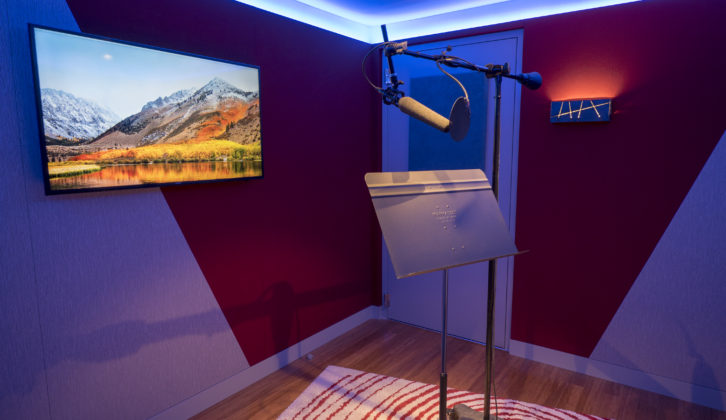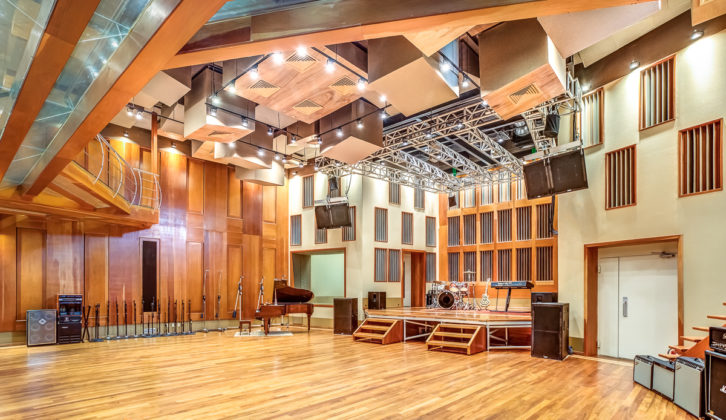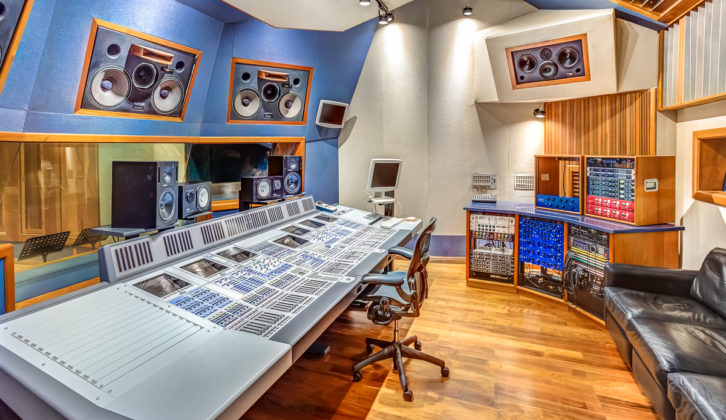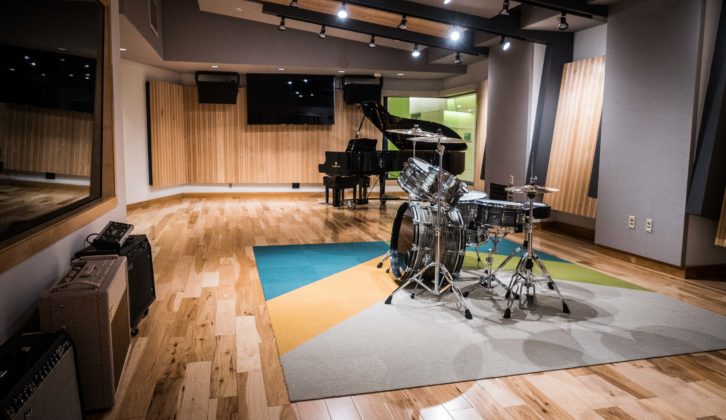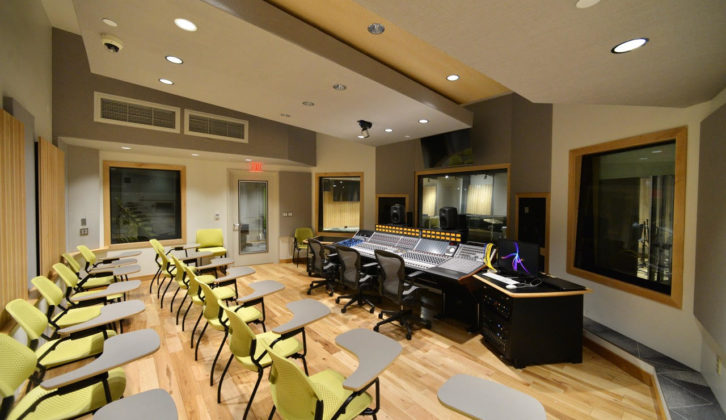Each June, Mix surveys facility designers and acousticians for their latest studio projects. This year’s “class” includes facilities in major and smaller U.S. markets, as well as new rooms and redesigns in Toronto, Monterrey and Rome. For more photos of these studios and others, visit mixonline.com.

Brighter Shade Studios, Atlanta, Ga.
Zac Brown Band founding member John Driskell Hopkins is the proud owner of this beautiful new studio, built into the attic of his Atlanta residence. The facility was designed by Steve Durr and Matt Schlachter of Steven Durr Designs to create a warm and inspiring space for Hopkins’ ZBB-related work and more.
The attic was unfinished when Hopkins and his wife, Jennifer, moved into their home. Durr and Schlachter first walked the site from one floor joist to another; there was no real floor or ceiling, and the walls were fluffy with pink insulation arranged around HVAC equipment and ductwork.
“We built a room-within-a-room construction, but we were particularly careful with the materials we chose in terms of weight and budget, because I don’t like to spend invisible money on things that don’t actually contribute to the recording process,” Durr says.
“Having designed 2,500 studios all over the world, I’ve learned some things about what’s important and what’s not,” Durr continues. “What’s really important is that the person who owns it walks in every day and says, ‘I can’t believe this is mine.’ Because I’m really not in the studio business; I’m in the emotion business. Music, and all audio, is an emotional experience.”
Contributing to Hopkins’ appreciation of his space are some of the qualities that give the studio character: 18-foot ceilings; the warm natural finishes chosen by Jenn, who is an interior designer; and the view through the large windows.

“So many studios are caves, and I just love all that light and the fact that we can see the changing seasons and watch the rainfall,” Hopkins says.
Ensconced in his spacious new studio since June, Hopkins is now using an API The Box console. He has also added to his cache of Neve 1073 and 1084 mic preamps. He monitors via Mackie XR824s and Yamaha NS-10s. His Aviom personal monitoring system serves up to eight musicians (eight members in the ZBB).
By all accounts, the process of constructing Brighter Shade Studio was smooth and relaxed. Hopkins says that the builder, Tommy Sweet of Cornerstone Associates, had not done studio work before, but the contractor and his crew were efficient and responsive, building perfect bass traps as if it were their daily work.
“And Steve and Matt are so easy to talk to—they’re just a great hang. They could be in anybody’s band!” Hopkins says. “They’re also good on-the-fly with making changes. If I needed to modify the design, they were quick to adjust and make sure I wouldn’t have any structural problem or audio problem. There was never a ‘No, you can’t do that.’ It was always, ‘Let’s figure out how you can do that.’”
Hi-Five Studio, Milwaukee. Wis.
Working closely with Hi-Five Studio owner Ryan Rosmann, Haverstick Designs helped to convert a century-old building into a 5,000-square-foot commercial recording facility, comprising two isolation booths, 1,300-square-foot live room, two amp rooms, control room and lounge. A “room within a room” design with extensive detail was implemented to isolate the studio from the surrounding residential neighborhood and adjacent dog park. Kinetics ISOMax Clips and Green Glue Noiseproofing Compound, along with standard building materials, were used in construction. Acoustical treatments include custom-designed ceiling clouds, bass traps and diffusers, as well as the Flex-48 Adaptive Treatment System by Acoustical Fulfillment. Hi-Five is equipped with a Rupert Neve Designs 5059 Satellite mixer and 16 RND 5052 mic pre/EQs, ATC SCM45A monitors, Manley Massive Passive and Vari Mu, and a Pro Tools HDX2 system with three Avid HD I/O.

Kiwi Audio, Batavia, Ill.
Kiwi Audio is a 1,200-square-foot studio facility located on a 124-acre working farm 50 miles west of Chicago. Designed by Jeff Hedback of HD Acoustics, the studio includes a 325-square-foot control room with an expansive window to the 550-square-foot tracking room. The 14-foot ceilings and suspended motorized “drumbrella” also add to the acoustic signature and vibe of the tracking room. Sound isolation systems were designed to yield an exceptionally quiet noise floor even when the farm equipment is in use. Kiwi offers a vintage DDA AMR24 console, Pro Tools HDX2, Barefoot MM27 main monitors with Rhythmic Audio subs, and an extensive collection of mics and outboard gear.
Related story: Class of 2017: 17 of the Year’s Coolest Studio Designs, June 14, 2017
Hondo Creek Recording, Pittsboro, N.C.
This new studio went online in January and was designed from the ground up by the Wes Lachot Design Group. The control room features a reflection-free design with extensive diffusion and bass trapping, and custom high-prime-number, rear-wall diffusors. The tracking room features variable acoustics and a diffusive cloud, and offers nice views of the natural surroundings. Acoustical installation was by Brett Acoustics; technical wiring by Canova Audio. Hondo Creek’s equipment includes an Avid S3 console and Speck Audio 32-channel summing mixer, as well as ATC SCM150 ASL active tri-amped monitors with ATC discrete power amps.
CDM Studios, New York, N.Y.
Opened in January 2018, Charles de Montebello’s CDM Studios is a newly expanded and busy voice recording and post-production facility. Francis Manzella’s FM Design firm has designed a number of facilities for CDM over the years, including the original design of their current location back in 2004. When de Montebello needed to expand, he again worked with Manzella on an additional ADR-capable voice-recording and mix suite. Manzella says that de Montebello wanted this studio “dialed up a notch,” including elaborate stretched fabric work, custom millwork and a signature FM Design floating ceiling cloud. Extensive trapping is included in the both the control room and dedicated booth (pictured). Equipment in the new room include a PreSonus Series III StudioLive 16 console; 4-channel Focusrite ISA428; Pro Tools 12, Reaper, and a variety of mics and plug-ins.

Red Vault Audio, South Portland, Maine
In Sonic Space’s design for Pete Morse’s Red Vault Audio facility, the objective was to create a great-sounding, one-room studio, with control room gear and tracking in the same space. After working in a basement studio for five years, Morse also wanted a more inspiring space with natural light and optimized acoustics. Designer Lou Clark explains that in this facility, the rear of the room is somewhat live with under a second of reverb, but the front is extremely dead, allowing for a variety of tracking possibilities. Red Vault is equipped with a Pro Tools HDX system with Crane Song, Dangerous and Apogee converters; ADAM S3X monitors with Crane Song Avocet IIA monitor controller, and a variety of outboard gear.
Victoria Records, Monterrey, Mexico
The Malvicino Design Group created the original design for Victoria Records in 2005, and last year, the studio again retained Horacio Malvicino to design a significant technical upgrade to accommodate a new 48-channel SSL Duality console in Studio A and an Avid S6 in the B room. The main studio includes a full glass mezzanine, three isolation booths and a stage with P.A. system. Variable acoustics are controlled from either control room A or B electronically via a jog wheel; motorized wall panels can be moved in increments of 2 degrees. In addition to the new consoles, Victoria Records offers a Pro Tools system and Studer 827 machine. Further amenities include on-site residential accommodations.
Related story: Class of 2016: 19 of the World’s Finest in Studio Design, May 30, 2016
Drexel University, Philadelphia, Pa.
The Walters-Storyk Design Group, led by partner/project manager Romina Larregina, provided design services for a new facility to support Drexel Westphal College’s growing College of Media Arts & Design. This 1,500-square-foot facility, geared to accommodate recording/production, mixing and classroom-style instruction, features a corner window from the student collaboration area with views into the main recording room. Also included in the facility are a 140-square-foot post-production control room, two 1,000-square-foot MIDI labs, a lounge and an 800-square-foot archive suite. WSDG designed custom acoustic treatments and isolated environments. Featured equipment includes a Neve 5088 console, Genelec 8040 and Avantone Mixcube monitors, Xilica 4080 speaker processing, and an extensive collection of outboard gear.
Cartoon Network Studio B, Burbank, Calif.
The Cartoon Network’s Studio B went online in July 2017. Designed by Kaufman and Associates, the studio is approximately 800 square feet and features a 5.1 control room and a comfortable stage area for recording a cast of voice actors. Control room equipment includes an Avid S6 24-channel console controlling a Pro Tools HDX system, ATC SCM25 LCR main monitors, and BAE Neve 1073 preamps.
The Upper Deck, Nashville, Tenn.
Carl Tatz Design created this personal recording studio within the home of Major League Baseball player Mark Trumbo of the Baltimore Orioles. This facility includes a Carl Tatz Design PhantomFocus MixRoom and a live tracking room with an 18-foot gabled ceiling. Trumbo’s studio went online this past October. His equipment includes a Tree Audio Roots Gen II console, PFM 2200-UHD monitors, Briscasti M7 stereo reverb processor, Eventide H8000FW multichannel effects system, and a large collection of vintage electric guitars and amps.
Related story: Class of 2015: Acoustic Design for 18 of This Year’s Coolest New Studios, June 2, 2015

LinkedIn Studios, Carpinteria, Calif.
LinkedIn’s many studios worldwide include six 5.1 post-production suites designed by DHDI, which employed its ZR Acoustics quantum devices to create an elegant aesthetic while delivering immersive acoustics, lifelike imaging and large sweet spots in a slim package. DHDI reports that the latest version of ZR SR24+ weighs 4 pounds and measures 1.25 inches thick; the product was used in conjunction with DHDI’s Hybrid, SR and Micro Technologies. Featured equipment in the studio pictured includes a Slate Raven MTi2 console, Grace m905 Stereo Reference Monitor Controller, Genelec monitors, Universal Audio Apollo 8 and Pro Tools HD.

SDI Media Italia, Rome, Italy
Munro Acoustics Design were the studio design firm on this Dolby Atmos post-production facility for SDI Media Italia. The approximately 35×20-foot theater pictured includes cinema seating for 11 people and two windows for natural light (and electric blinds for a dark room). The audio system includes capabilities for Dolby Atmos 9.1, 7.1, 5.1 or stereo playback via JBL 3731T, 4642A, 9310 and SCS12 monitors, as well as JBL 4645 subs. Monitors are powered by Crown amplifiers. SDI Media also utilizes an Avid S6 56-fader control surface, Pro Tools HDX 3 (192 MADI channels) and HDX 2 (128 MADI channels), and a wealth of in-the-box processing.
Related story: Class of 2014: A Collection of This Year’s Hottest New Studios, by Barbara Schultz, June 1, 2014

Berkeley Inc., Toronto, Ontario
This project, designed by Pilchner Schoustal International, involved the conversion of an historic row house into a modern post-production studio facility for owner Jared Kuemper. The studio features a 5.1 control room with lots of natural light and room for clients to enjoy the unique setting and its private garden. Berkeley Inc. creates music and sound for agencies, production companies and direct clients through casting, voiceover, music composition and sound design. The studio equipment includes a Pro Tools system, a Barefoot MicroMain 35 5.1 monitoring system, and outboard gear from Focusrite, Manley and others.
Related stories:
• Class of 2017, June 14, 2017
• Class of 2016, May 30, 2016
• Class of 2015, June 2, 2015
• Class of 2014, June 1, 2014
• Class of 2013, June 1 2013
• Class of 2011, June 1, 2011
• Class of 2010, May 20, 2010
• Class of 2009, June 1, 2009
• Class of 2008, June 1, 2008
• Class of 2007, June 1, 2007
• Class of 2006, June 1, 2006
• Class of 2005, June 1, 2005
• Class of 2004, June 1, 2004
• Class of 2003, June 1, 2003
• Class of 2002, June 1, 2002
• Class of 2001, June 1, 2001





